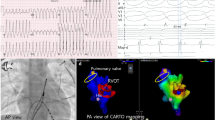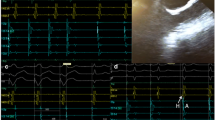Abstract
Radiofrequency catheter ablation (RFCA) has proven safe for most young patients, but the risk of inadvertent atrioventricular (AV) block remains. The purpose of this report is to describe techniques to avoid inadvertent AV block during effective RFCA in young patients with septal tachycardia substrates.
Methods: The techniques included intubation and apnea during RFCA, coronary sinus pacing during RFCA to observe intact AV conduction during junctional ectopy, localizing the optimal His electrogram prior to RFCA, not ablating during tachycardia and titrating power output with temperature monitoring.
Results: In the period January 1995–June 2001, RFCA of 424 tachycardia substrates was performed. A total of 217 consecutive septal tachycardia substrates are included in this report. Apnea eliminated a mean catheter tip displacement of 5.4 +/− 2.5 mm seen during respiration. No patient experienced transient or permanent complete AV block after any of the 217 substrate ablation procedures. All of the patients had normal PR intervals following ablation without development of any degree of AV block in 194 patients at latest follow-up. RFCA success for substrates with septal accessory pathways was 87/96 (91%), permanent junctional reciprocating tachycardia (PJRT) 15/16 (94%), typical atrioventricular node reentry tachycardia (AVNRT) 82/85 (96%), atypical AVNRT 6/7 (86%) and intra-atrial reentry tachycardia (IART) 10/13 (77%). Fluoroscopy time averaged 10.8 minutes. For patients with accessory pathway, 8 (7.9%) developed a recurrence.
Conclusion: Catheter stability is paramount to safe and effective RFCA in septal locations. Use of these techniques resulted in acceptable success rates and low recurrence rate for RFCA of septal tachycardia substrates while avoiding inadvertent AV block in these young patients.
Similar content being viewed by others
References
Kugler JD, Danford DA, Deal BJ, Gillette PC, Perry JC, Silka MJ, Van Hare GF, Walsh EP.Radiofrequency catheter ablation for tachyarrhythmias in children and adolescents. The Pediatric Electrophysiology Society. N Engl J Med 1994;330:1481–1487.
Van Hare GF, Lesh MD, Scheinman M, Langberg JJ. Percutaneousradiofrequency catheter ablation for supraventricular arrhythmias in children. J Am Coll Cardiol 1991;17:1613–1620.
Teixeira OHP, Balaji S, Case CL, Gillette PC. Radiofrequency catheter ablation of atrioventricular nodal reentranttachycardia in children. PACE 1994;17:1621–1626.
Schaffer MS, Silka MJ, Ross BA, Kugler JD, andParticipating Members of the Pediatric Electrophysiology Society. Inadvertent atrioventricular block during radiofrequency catheter ablation. Results of the Pediatric Radiofrequency Ablation Registry. Circulation 1997;94:3214–3220.
Wathen M, Natale A, Wolfe K, Yee R, Newman D, Klein G. An anatomically guided approach to atrioventricular nodeslow pathway ablation. Am J Cardiol 1992;70:886–889.
Thakar RK, Klein GJ, Yee R, Stites HW.Junctional tachycardia: A useful marker during radiofrequency ablation for atrioventricular node reentrant tachycardia. J AmColl Cardiol 1993;22:1706–1710.
Kuch KH, Schluter M, Gursoy S. Preservation of atrioventricularnodal conduction during radiofrequency catheter ablation of midseptal accessory pathways. Circulation 1992;86:1743–1752.
Langberg J, Leon A, Borganelli M, Kalbfleisch S, El-Atassi R, Calkins H, Morady F.Arandomized prospective comparison of anterior and posterior approaches to atrioventricular node slow pathway ablation. Circulation 1993;87:1551–1557.
Davis LM, Byth K, Ellis P, McGuire MA, Uther JB, Richards DAB, Ross DL. Dimensions of the human posterior septal space and coronary sinus. Am J Cardiol 1991;68:621–625.
Ueng KC, Chen SA, Chiang CE, Tai CT, Lee SH, Chion CW, Wen ZC, Tseng CJ, Chen YJ, Yu WC, Chen CY, Chang MS. Dimension and anatomical distance of Koch's triangle in patients with atrioventricular nodal reentrant tachycardia. J Cardiovasc Electrophysiol 1996;7:1017–1023.
Greene TO, Huang SKS, Wagshal AB, Mittleman RS, Pires LA, Mazzola F, Andress JD. Cardiovascular complications after radiofrequency catheter ablation of supraventricular tachyarrhythmias. Am J Cardiol 1994;74:615–617.
Danford DA, Kugler JD, Deal B, Case C, Friedman RA, Saul JP, Silka MJ, Van Hare GF. The learning curve forradiofrequency catheter ablation of tachyarrhythmias in pediatric patients. Participating Members of the Pediatric Electrophysiology Society. Am J Cardiol 1995;75:587–590.
Cote JM, Epstein MR, Triedman JK, Walsh EP, Saul JP.Low-temperature mapping predicts site of successful ablation while minimizing myocardial damage. Circulation 1996;94:253–257.
Author information
Authors and Affiliations
Rights and permissions
About this article
Cite this article
Pecht, B., Maginot, K.R., Boramanand, N.K. et al. Techniques to Avoid Atrioventricular Block During Radiofrequency Catheter Ablation of Septal Tachycardia Substrates in Young Patients. J Interv Card Electrophysiol 7, 83–88 (2002). https://doi.org/10.1023/A:1020828401929
Issue Date:
DOI: https://doi.org/10.1023/A:1020828401929




